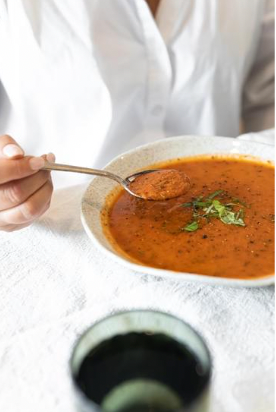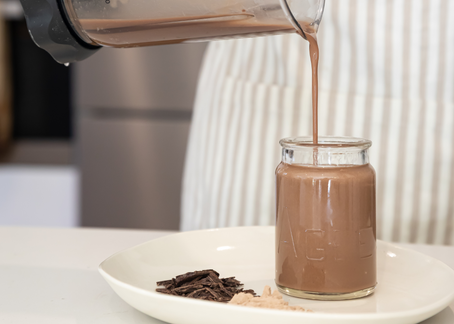Meal times are an important part of family life, but we know they can be challenging if you are trying to lose weight. Cooking a low calorie meal for you, while also balancing fussy eaters, hungry teenagers or an unsupportive spouse, can make it seem impossible. But you certainly don’t need to sit and watch your family indulge, while you nibble on a lettuce leaf. With some creativity and planning you can make family meal times great without sabotaging your weight loss.
Here are some practical tips to help you with the weight loss/family juggle.
1. Get your family on board
Research has shown that weight loss is more effective if you have family support, so it is in your best interests to get them on board. Explain that you are embarking on a health journey and would like them to come along for the ride. Emphasise the benefits of healthy eating more than on how much broccoli they will now have to eat!
Engaging the kids will make life easier for you but also teach them valuable habits. Younger children could have a sticker chart for trying unusual vegetables; involve them in choosing the next new vegetable. Older kids can help plan menus and cook. They won’t turn their noses up at dinner if they cooked it!
If you live with other adults, ask them for their support and encouragement. Share with them your weight loss WHY.
What if my family isn’t supportive?
Sadly, sometimes family members aren’t supportive of your weight loss efforts? They often have their own issues with food and body image and this can sabotage your weight loss goals. If your family doesn't support you - find someone who will. Join a Facebook page, call a friend, join a gym.
Hopefully in time your family will see how good the change is for you and get on board. But in the meantime, become your own cheerleader - write notes of encouragement to yourself and put them around the house; set an alarm on your phone that motivates you. Post yourself a letter, telling yourself how proud you are of your weight loss efforts. If family won’t support you, find someone who will, even if it’s yourself.
2. Remove temptation
Have a deep cleanse of your kitchen to remove the food that derails you. If these foods aren’t great for you, they aren’t helpful for your family either, so it is a good opportunity to help everyone and get that food out of the house.
This is the perfect time for a family health check - are you enabling them to sustain unhealthy eating patterns? Unhelpful habits need to be broken (yours and theirs). Yes, there will be some moaning, but the kids quickly realise they feel better when they eat healthily and that fresh fruit and vegetables are actually much tastier than biscuits and chips. By helping yourself, you are also helping your family.
If you truly can’t remove junk food, then make them difficult to access. Put it in a plastic container, on a high shelf. The more effort it takes to get it, the less likely you will be to eat it.
3. Plan Plan Plan
It's those nights when you haven’t planned anything for dinner that frozen pizza become the easy choice. For the most part, convenience foods contain hidden calories, preservatives, fats and sugars. Cooking from whole foods, (while it takes a little more time) is almost always better for your weight and your family’s health. But don’t be overwhelmed - with a little bit of planning, cooking from scratch is easy. Set aside a time each week to plan for the next 7 meals. Write a shopping list and then shop to that list.
Let the kids help plan too - do they prefer carrots or pumpkin? Beans or broccoli? Put them in charge of choosing a recipe each week (set some guidelines to make sure it’s healthy) and get them cooking.
On busy nights, use the Slow cooker (put it on in the morning) or cook double one night and have leftovers the next. Be careful not to eat the leftovers too soon (more on that later). Set an alarm to remember to defrost the meat the night before.
4. Supermarket shop online
Shopping online makes weight loss easier! It can be too tempting to walk around the supermarket (especially if you are hungry) and unhelpful food can miraculously end up in your trolley. If you shop online and shop to a list you are more likely to use your head and not your stomach to make food choices.
5. Modify the meal
Same but different. It is incredibly time consuming to have to cook two meals - one for yourself and one for the family. It’s a hurdle you don’t need to jump. It’s simpler to cook a similar meal for everyone, but to modify it to reduce the calories for yourself. The easiest way to do this is to have the same protein and vegetables as the rest of the family, but reduce your carbs. For example, if the family is having steak and mashed potatoes, skip the potatoes and have more vegetables. If the meal is carb heavy (try and keep these to a minimum) like pasta, then choose protein or carbs but not both - for example, if its Spag Bol, just have the meat sauce (missing the spaghetti) and a salad, or, just have the spaghetti with the tomato sauce but skip the mince.
CUT and SWAP are two key words to help you modify the family meal for weight loss. CUT out the high calorie additions (carbs, cheese, mayonnaise, sour cream) and SWAP what you can for low calorie options (eg, try our new low calorie dressings, swap pasta for zucchini noodles or use a tomato sauce instead of a creamy one). A lot of the time your kids won’t even notice you are having something different.
6. Be careful with leftovers
Some people are advocates of cooking once eating twice - cooking extra and having the leftovers the next day. But be careful of this - if you are very disciplined it can minimise time in the kitchen, but if you struggle with self control, leftovers can turn into second helpings, or a few mouthfuls from the fridge at midnight.
Be honest with yourself about whether cooking double batches would help or hinder you. Also watch out for eating scraps off your children’s plates (be honest… we’ve all done it!). A few crusts here, a spoon of mac n cheese there, can ramp up your calorie intake without you even realising. Put leftovers straight into the rubbish bin (and cover with rubbish). If you are keeping them for another meal, put them straight into the freezer (hard to snack on if it’s frozen).
7. Portion Control
When you cook for others getting the quantities right can be tricky - over sized portions can easily slip in. Measure portions before cooking, so you can keep them under control. For example, measure half a cup of rice per person (don’t just guesstimate), count 1 or 2 potatoes per person and don’t cook any more.
You can also try cutting up vegetables and storing them in the fridge in snap lock bags - for quick and easy meal prep.
Cooking with whole pieces of food rather than cut up pieces can also help with portion control. For example, it is easier to overeat if you cut up the chicken for a stir fry - it’s hard then to gauge how much you have eaten. If you keep the chicken breast whole, you can have your piece and that’s it. It’s easier to just eat one potato, if its baked whole, than it is if it’s cut up into fries.
Food boxes or Kits are another great way to avoid overeating. The portions are set in concrete, so you can’t eat too much. They also make meal prep easy. If you think a Food Box would work for you, try to choose a low calorie option.
8. What if I am replacing all my meals with FastFx?
If you are replacing all 3 meals or you are doing the FastFx 2 Week Weight Loss Challenge, cooking for your family will be a bit trickier - because you are having a smoothie instead of dinner. But it is still possible to make it work.
Firstly though, if you know you struggle to be around food and even cooking is too tempting (I’m talking to all you bowl lickers and ‘taste as you cook’ chefs) then ask someone else to cook while you are in this intensive stage. Hopefully they are supportive and keen to help. If this is you, you might even have to skip the family meal time for a while - go for a walk, read a book, watch TV, and then join the family after the dishes are done for a board game or movie. Eating together is a really wonderful activity for a family, but, if you find being around food too challenging, find other ways to build relationships that don’t revolve around food - just while you are in this intensive stage of your weight loss.
But, if you can cope, have dinner with the family with a few modifications to your meal. You will be having your 2 cups of vegetables, so use these vegetables as the base (and not the afterthought) of your family meal. Use the recipes we have put together in the HealthFx CookBook (or come up with your own vegetable recipes - try to keep them to under 100 calories per serve). Now add a piece of protein and a few carbs for your family. For example, you can make a Japanese Salad (for you) and add grilled chicken and rice for the family.
9. Be body positive
It can be difficult to lose weight and not send the message to your children that there is something wrong, or ‘bad’ about your (or their) body. This is a hard line to walk, and must be done with care and consideration. Many of us have unhealthy relationships with our bodies and food because of messaging from our families, so it is important that your kids don’t hear you criticising your body or putting yourself down. Instead talk about health, energy and good fuel.
Replace words like “skinny” with “a healthy weight”, replace “diet” with “healthy food choices”, instead of “treat foods”, say “sometimes food”, replace “I’m not allowed to eat that” with “I choose not to eat that”.
Make your health journey sound fun and positive by focusing on what you stand to gain by losing weight.
10. Be a great role model
Your kids watch every move you make - so use this as an opportunity to model healthy choices, portion control, the joy of fresh, whole foods, self control and self love. Show them how delicious and enjoyable healthy eating can be. Show them how to love themselves enough to want to be healthy and to make good food choices. If you didn’t come from a family that had a healthy relationship with food, make sure your family does. Children who see parents eating well are much more likely to have a healthy weight and go onto build healthy, lifelong eating habits.
So yes, weight loss is harder if you are also cooking for a family, but it is possible. In fact, with some planning, preparation and substitutions, you can turn it into a positive experience for the whole family. Remember to stay strong, get support, and model healthy choices and self love.
One of the greatest gifts you can give your family is a healthy you!





















